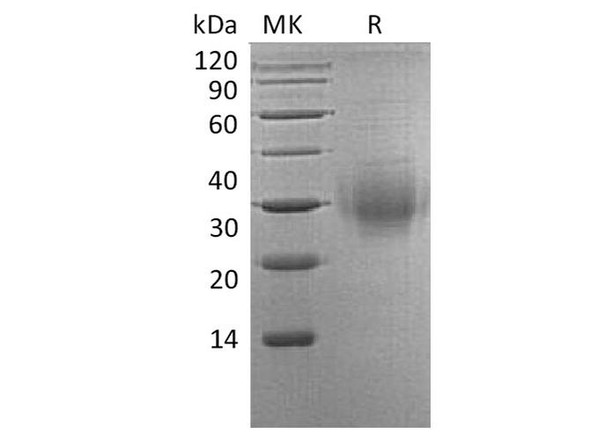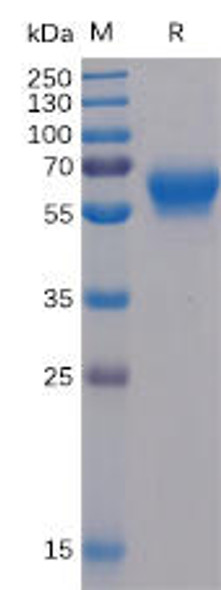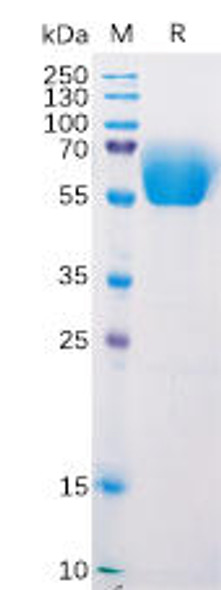Description
| Product Name: | Human BTLA Recombinant Protein |
| Product Code: | RPPB2915 |
| Size: | 10µg |
| Species: | Human |
| Target: | BTLA |
| Synonyms: | B- and T-lymphocyte attenuator, B- and T-lymphocyte-associated protein, CD272, B And T Lymphocyte Associated, B- And T-Lymphocyte-Associated Protein, B- And T, Lymphocyte Attenuator, CD272 Antigen, BTLA1. |
| Source: | Sf9 Insect cells |
| Physical Appearance: | Sterile filtered colorless solution. |
| Formulation: | BTLA protein solution (0.5mg/ml) contains Phosphate Buffered Saline (pH 7.4) and 10% glycerol. |
| Stability: | Store at 4°C if entire vial will be used within 2-4 weeks. Store, frozen at -20°C for longer periods of time. For long term storage it is recommended to add a carrier protein (0.1% HSA or BSA).Avoid multiple freeze-thaw cycles. |
| Purity: | Greater than 90.0% as determined by SDS-PAGE. |
| Amino Acid Sequence: | ADPKESCDVQ LYIKRQSEHS ILAGDPFELE CPVKYCANRP HVTWCKLNGT TCVKLEDRQT SWKEEKNISF FILHFEPVLP NDNGSYRCSA NFQSNLIESH STTLYVTDVK SASERPSKDE MASRPWLLYS HHHHHH |
BTLA, also known as B And T Lymphocyte Associated, is an inhibitory molecule which is part of the Ig superfamily. BTLA is a type 1 transmembrane glycoprotein in the CD28 family of T cell costimulatory molecules. BTLA is a 3rd inhibitory receptor on T lymphocytes with resemblances to CTLA-4 & PD-1. Moreover, BTLA is a ligand for TNF (receptor) superfamily, TNFRSF14, and HVEM. BTLA-HVEM complexes negatively regulate T-cell immune responses.
BTLA produced in Sf9 Insect cells is a single, glycosylated polypeptide chain containing 136 amino acids (31-157 a.a.) and having a molecular mass of 15.7kDa (Molecular size on SDS-PAGE will appear at approximately 18-28kDa).BTLA is expressed with a 9 amino acid His tag at C-Terminus and purified by proprietary chromatographic techniques.
| UniProt Protein Function: | Lymphocyte inhibitory receptor which inhibits lymphocytes during immune response. |
| NCBI Summary: | This gene encodes a member of the immunoglobulin superfamily. The encoded protein contains a single immunoglobulin (Ig) domain and is a receptor that relays inhibitory signals to suppress the immune response. Alternative splicing results in multiple transcript variants. Polymorphisms in this gene have been associated with an increased risk of rheumatoid arthritis. [provided by RefSeq, Aug 2011] |
| UniProt Code: | Q7Z6A9 |
| NCBI GenInfo Identifier: | 296439425 |
| NCBI Gene ID: | 151888 |
| NCBI Accession: | Q7Z6A9.3 |
| UniProt Secondary Accession: | Q7Z6A9,Q3B831, Q3HS85, Q6ZNH9, |
| UniProt Related Accession: | Q7Z6A9 |
| Molecular Weight: | 27,317 Da |
| NCBI Full Name: | B- and T-lymphocyte attenuator |
| NCBI Synonym Full Names: | B and T lymphocyte associated |
| NCBI Official Symbol: | BTLA�� |
| NCBI Official Synonym Symbols: | BTLA1; CD272�� |
| NCBI Protein Information: | B- and T-lymphocyte attenuator |
| UniProt Protein Name: | B- and T-lymphocyte attenuator |
| UniProt Synonym Protein Names: | B- and T-lymphocyte-associated protein; CD_antigen: CD272 |
| Protein Family: | B- and T-lymphocyte attenuator |
| UniProt Gene Name: | BTLA�� |










